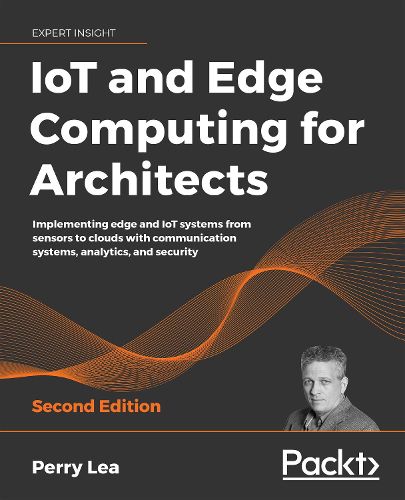Readings Newsletter
Become a Readings Member to make your shopping experience even easier.
Sign in or sign up for free!
You’re not far away from qualifying for FREE standard shipping within Australia
You’ve qualified for FREE standard shipping within Australia
The cart is loading…






This title is printed to order. This book may have been self-published. If so, we cannot guarantee the quality of the content. In the main most books will have gone through the editing process however some may not. We therefore suggest that you be aware of this before ordering this book. If in doubt check either the author or publisher’s details as we are unable to accept any returns unless they are faulty. Please contact us if you have any questions.
Learn to design, implement, and secure your IoT infrastructure. Revised and expanded for edge computing.
Key Features
Build a complete IoT system that’s the best fit for your organization Learn about different concepts, tech, and trade-offs in the IoT architectural stack Understand the theory and implementation of each element that comprises IoT design
Book DescriptionIndustries are embracing IoT technologies to improve operational expenses, product life, and people’s well-being. An architectural guide is needed if you want to traverse the spectrum of technologies needed to build a successful IoT system, whether that’s a single device or millions of IoT devices.
IoT and Edge Computing for Architects, Second Edition encompasses the entire spectrum of IoT solutions, from IoT sensors to the cloud. It examines modern sensor systems, focusing on their power and functionality. It also looks at communication theory, paying close attention to near-range PAN, including the new Bluetooth ® 5.0 specification and mesh networks. Then, the book explores IP-based communication in LAN and WAN, including 802.11ah, 5G LTE cellular, Sigfox, and LoRaWAN. It also explains edge computing, routing and gateways, and their role in fog computing, as well as the messaging protocols of MQTT 5.0 and CoAP.
With the data now in internet form, you’ll get an understanding of cloud and fog architectures, including the OpenFog standards. The book wraps up the analytics portion with the application of statistical analysis, complex event processing, and deep learning models. The book then concludes by providing a holistic view of IoT security, cryptography, and shell security in addition to software-defined perimeters and blockchains.
What you will learn
Understand the role and scope of architecting a successful IoT deployment Scan the landscape of IoT technologies, from sensors to the cloud and more See the trade-offs in choices of protocols and communications in IoT deployments Become familiar with the terminology needed to work in the IoT space Broaden your skills in the multiple engineering domains necessary for the IoT architect Implement best practices to ensure reliability, scalability, and security in your IoT infrastructure
Who this book is forThis book is for architects, system designers, technologists, and technology managers who want to understand the IoT ecosphere, technologies, and trade-offs, and develop a 50,000-foot view of IoT architecture. An understanding of the architectural side of IoT is necessary.
$9.00 standard shipping within Australia
FREE standard shipping within Australia for orders over $100.00
Express & International shipping calculated at checkout
This title is printed to order. This book may have been self-published. If so, we cannot guarantee the quality of the content. In the main most books will have gone through the editing process however some may not. We therefore suggest that you be aware of this before ordering this book. If in doubt check either the author or publisher’s details as we are unable to accept any returns unless they are faulty. Please contact us if you have any questions.
Learn to design, implement, and secure your IoT infrastructure. Revised and expanded for edge computing.
Key Features
Build a complete IoT system that’s the best fit for your organization Learn about different concepts, tech, and trade-offs in the IoT architectural stack Understand the theory and implementation of each element that comprises IoT design
Book DescriptionIndustries are embracing IoT technologies to improve operational expenses, product life, and people’s well-being. An architectural guide is needed if you want to traverse the spectrum of technologies needed to build a successful IoT system, whether that’s a single device or millions of IoT devices.
IoT and Edge Computing for Architects, Second Edition encompasses the entire spectrum of IoT solutions, from IoT sensors to the cloud. It examines modern sensor systems, focusing on their power and functionality. It also looks at communication theory, paying close attention to near-range PAN, including the new Bluetooth ® 5.0 specification and mesh networks. Then, the book explores IP-based communication in LAN and WAN, including 802.11ah, 5G LTE cellular, Sigfox, and LoRaWAN. It also explains edge computing, routing and gateways, and their role in fog computing, as well as the messaging protocols of MQTT 5.0 and CoAP.
With the data now in internet form, you’ll get an understanding of cloud and fog architectures, including the OpenFog standards. The book wraps up the analytics portion with the application of statistical analysis, complex event processing, and deep learning models. The book then concludes by providing a holistic view of IoT security, cryptography, and shell security in addition to software-defined perimeters and blockchains.
What you will learn
Understand the role and scope of architecting a successful IoT deployment Scan the landscape of IoT technologies, from sensors to the cloud and more See the trade-offs in choices of protocols and communications in IoT deployments Become familiar with the terminology needed to work in the IoT space Broaden your skills in the multiple engineering domains necessary for the IoT architect Implement best practices to ensure reliability, scalability, and security in your IoT infrastructure
Who this book is forThis book is for architects, system designers, technologists, and technology managers who want to understand the IoT ecosphere, technologies, and trade-offs, and develop a 50,000-foot view of IoT architecture. An understanding of the architectural side of IoT is necessary.